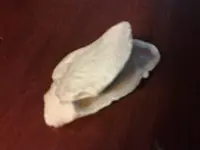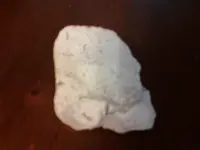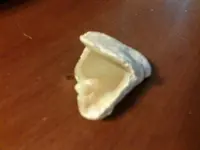You are using an out of date browser. It may not display this or other websites correctly.
You should upgrade or use an alternative browser.
You should upgrade or use an alternative browser.
got a question...
- Thread starter yakker
- Start date
- Joined
- Jan 27, 2009
- Messages
- 18,871
- Reaction score
- 12,119
- Golden Thread
- 1
- Location
- South East Tennessee on Ga, Ala line
- 🥇 Banner finds
- 1
- Detector(s) used
- Tesoro Conquistador freq shift
Fisher F75
Garrett AT-Pro
Garet carrot
Neodymium magnets
5' Probe
- Primary Interest:
- All Treasure Hunting
That is the weirdest rock I have ever seen. I know what it is but I have no idea why it is like that  Almost like a clam.
Almost like a clam.
 Almost like a clam.
Almost like a clam.yakker
Bronze Member
- #5
Thread Owner
That is one solid piece. Crazy, no? It looks like jasper or tan chert- the outside is obviously aged 'crust', but it cracked open just like that-- open. Mother nature is a trickster. I keep it in my basket of 'what the heck is This' stuff. Few rocks in that basket. Mostly big old teeth that I can't identify. But this funny rock get me every time I look at it. Strange-- and I have to think heat did it. But who knows... Thanks for looking- regardless of how silly the topic. Yak
redbeardrelics
Hero Member
- Joined
- Jan 3, 2014
- Messages
- 891
- Reaction score
- 1,024
- Golden Thread
- 0
- Location
- Maryland's Eastern Shore
- Detector(s) used
- Garrett GTI 2500, (Ace 250 spare)
- Primary Interest:
- Other
I was thinking it looked like some sort of mollusk remains as well, with maybe the different color inside being the result of that?? Maybe fossilized now into rock, and from an extinct species making it unrecognizable to my salivating palette ?? That's my guess and I'm sticking to it like spat on rock. ; )
wvplug
Sr. Member
- Joined
- Mar 2, 2014
- Messages
- 343
- Reaction score
- 101
- Golden Thread
- 0
- Location
- Randolph County, WV
- Detector(s) used
- AT Pro and Pro Pointer
- Primary Interest:
- All Treasure Hunting
It does resemble a mollusk shell. It looks like a weathered dead animal on the outside, with all the periostracum completely worn away, but the nacre in the picture would indicate a more recent dead animal because the nacre still appears to have a deep shiny finish. I would have to get better pictures and good idea of scale. Are you sure it is one solid piece or does it hinge and bend? Because if it is a bivalve and the valves were closed, protecting the nacre over most of the weathering period, it would not necessarily be uncommon to have a better preserved shiny nacre. If it is one solid piece then this probably is not the case as the nacre would likely have been exposed to the elements the same as the outside of the shell. But not necessarily, if it were a snail species and inverted (meaning the inside was laying down in the mud with the outside facing the elements) then we could still see a similar scenario. Especially if it was found on the surface and out of the water in an area that was say more likely to experience acid rain. Though I think this would be less likely.
Is the outside soft and chalky? Is the inside smooth and slick? Was it found in or near a natural water source? Were there other similar pieces in the area? Did you dig this or find it laying on the surface? Do I ask too many questions? :O)
Why did you post in this forum? Was this found in a known Native American artifact area? I ask because you do not indicate where you live and it may be a piece of a shell midden. Again unlikely as one never finds really nice nacre in old shell midden.
Is the outside soft and chalky? Is the inside smooth and slick? Was it found in or near a natural water source? Were there other similar pieces in the area? Did you dig this or find it laying on the surface? Do I ask too many questions? :O)
Why did you post in this forum? Was this found in a known Native American artifact area? I ask because you do not indicate where you live and it may be a piece of a shell midden. Again unlikely as one never finds really nice nacre in old shell midden.
monsterrack
Silver Member
- Joined
- Apr 15, 2013
- Messages
- 4,419
- Reaction score
- 5,827
- Golden Thread
- 0
- Location
- Southwest Mississippi
- Detector(s) used
- Garrett, and Whites
- Primary Interest:
- All Treasure Hunting
JMO it looks like a creek pebble that was cracked in a fracture line by freezing.
NC field hunter
Silver Member
It reminds me of a clam shell or a mussel shell. Odd piece....
yakker
Bronze Member
- #11
Thread Owner
Wow- so many responces-- and was thinking this would sink to the bottom of the page and be one of those joke threads... Monsterrack- I believe you are right- I suspected this too. WVPlug, no, you don't ask too many questions. I, like many here forget that I need to post my (general) local w/ every post, and not assume everyone has already read where I am. I'm Eastern Shore, MD. It was water-found- in tidal area. It was found in a very productive 'wash-out' area where I've found quite a few artifacts of varying ages- otherwise I would have posted it on another forum. It's not hinged, and I don't believe it's a fossil of a mollusk. There are tons of old oyster middens around here, some washed out, some still buried in fields and forests, and although I have found lots of petrified wood, I have never found a mollusk fossil...yet. But you offered up some really good information (and words I had to look up  ) which I will keep in mind as I wander around looking for watery treasure. So thanks for taking the time to explain- or propose- all that. Sorry about the quality (or lack thereof) of the pics. And the lack of scale. It's not chalky, but a crust, as an aged piece of chert would develop over a loooooong time. The inside is slick like a wacked, fine grained stone. It's about 2.5 inches at the widest.
) which I will keep in mind as I wander around looking for watery treasure. So thanks for taking the time to explain- or propose- all that. Sorry about the quality (or lack thereof) of the pics. And the lack of scale. It's not chalky, but a crust, as an aged piece of chert would develop over a loooooong time. The inside is slick like a wacked, fine grained stone. It's about 2.5 inches at the widest.
And now I'm going to get some fried oysters. This has made me very hungry. And the rock will remain in the basket. Thanks all, for taking more than enough time to consider what may have caused this piece to be what it is! Yakker
 ) which I will keep in mind as I wander around looking for watery treasure. So thanks for taking the time to explain- or propose- all that. Sorry about the quality (or lack thereof) of the pics. And the lack of scale. It's not chalky, but a crust, as an aged piece of chert would develop over a loooooong time. The inside is slick like a wacked, fine grained stone. It's about 2.5 inches at the widest.
) which I will keep in mind as I wander around looking for watery treasure. So thanks for taking the time to explain- or propose- all that. Sorry about the quality (or lack thereof) of the pics. And the lack of scale. It's not chalky, but a crust, as an aged piece of chert would develop over a loooooong time. The inside is slick like a wacked, fine grained stone. It's about 2.5 inches at the widest.And now I'm going to get some fried oysters. This has made me very hungry. And the rock will remain in the basket. Thanks all, for taking more than enough time to consider what may have caused this piece to be what it is! Yakker
Last edited:
mamabear
Silver Member
- Joined
- Feb 21, 2008
- Messages
- 3,071
- Reaction score
- 867
- Golden Thread
- 0
- Location
- SE Missouri
- Detector(s) used
- garage sale oldie
- Primary Interest:
- Other
Don't know what it is , but I would keep it in my "odd" collection also.
Similar threads
- Replies
- 23
- Views
- 1K
- Suggestion
- Replies
- 8
- Views
- 720
Users who are viewing this thread
Total: 1 (members: 0, guests: 1)






